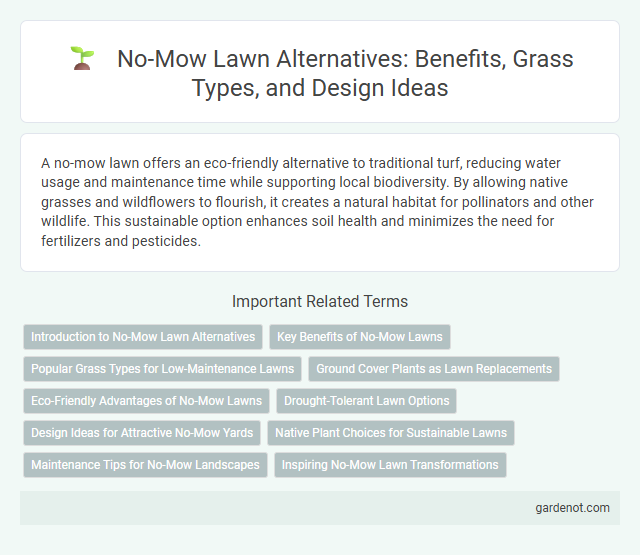A no-mow lawn offers an eco-friendly alternative to traditional turf, reducing water usage and maintenance time while supporting local biodiversity. By allowing native grasses and wildflowers to flourish, it creates a natural habitat for pollinators and other wildlife. This sustainable option enhances soil health and minimizes the need for fertilizers and pesticides.
Introduction to No-Mow Lawn Alternatives
No-mow lawn alternatives offer eco-friendly options that reduce maintenance while promoting biodiversity and water conservation. Popular choices include clover, native ground covers, and ornamental grasses, which thrive without frequent mowing and enhance soil health. These alternatives help lower carbon emissions, save time, and create aesthetically pleasing landscapes suitable for residential and commercial properties.
Key Benefits of No-Mow Lawns
No-mow lawns significantly reduce water consumption by requiring minimal irrigation compared to traditional grass, promoting sustainable landscaping. These low-maintenance alternatives enhance biodiversity by supporting pollinators and native plant species, contributing to healthier ecosystems. Soil health improves through reduced chemical use and less frequent disturbance, leading to better carbon sequestration and long-term environmental benefits.
Popular Grass Types for Low-Maintenance Lawns
Buffalo grass, fescue, and zoysia are popular grass types ideal for low-maintenance, no-mow lawns due to their drought tolerance and slow growth rates. These grasses require minimal watering, trimming, and fertilization, making them perfect alternatives to traditional turfgrass. Choosing species like buffalo grass enhances sustainability by reducing water usage and mowing frequency in residential landscapes.
Ground Cover Plants as Lawn Replacements
Ground cover plants such as creeping thyme, clover, and moss offer sustainable alternatives to traditional lawns by reducing the need for mowing, watering, and chemical inputs. These plants provide dense, low-maintenance greenery that resists weeds and supports biodiversity, enhancing soil health and attracting pollinators. Selecting regionally adapted ground covers ensures optimal growth and environmental benefits while promoting water conservation and reducing carbon footprints associated with conventional turfgrass maintenance.
Eco-Friendly Advantages of No-Mow Lawns
No-mow lawns significantly reduce water consumption compared to traditional turfgrass, promoting sustainable water management. These low-maintenance alternatives support biodiversity by providing habitat for pollinators and beneficial insects, enhancing local ecosystems. Reduced reliance on gas-powered mowers and chemical fertilizers further lowers carbon emissions and minimizes environmental pollution.
Drought-Tolerant Lawn Options
Drought-tolerant lawn options provide sustainable alternatives to traditional grass, conserving water and reducing maintenance. Native grasses such as buffalo grass, blue grama, and fescue thrive in arid conditions while maintaining green coverage year-round. Groundcovers like clover and sedum offer resilient, low-water landscapes that support biodiversity and resist drought stress effectively.
Design Ideas for Attractive No-Mow Yards
Designing an attractive no-mow yard involves using low-maintenance ground covers such as clover, sedum, or native grasses that provide texture and color without regular mowing. Incorporate ornamental plants like lavender, creeping thyme, and ornamental grasses to add visual interest and seasonal variation. Strategic placement of stone pathways, garden beds, and natural mulch areas enhances curb appeal while maintaining a sustainable, eco-friendly landscape.
Native Plant Choices for Sustainable Lawns
Native plant choices for no-mow lawns enhance sustainability by supporting local biodiversity and reducing water consumption. Species such as buffalo grass, blue grama, and wildflowers like Black-eyed Susan thrive with minimal maintenance while providing habitat for pollinators. These native alternatives improve soil health and decrease the need for fertilizers and pesticides, promoting an eco-friendly landscape.
Maintenance Tips for No-Mow Landscapes
No-mow landscapes require minimal upkeep, focusing on occasional weeding and targeted watering to promote drought tolerance and soil health. Mulching around plants helps retain moisture and suppresses weeds, reducing the need for frequent interventions. Choosing native grasses and ground covers enhances resilience and reduces pest problems, ensuring a sustainable, low-maintenance lawn alternative.
Inspiring No-Mow Lawn Transformations
No-mow lawns offer a sustainable alternative to traditional grass, significantly reducing water use and maintenance efforts. Transformations featuring native ground covers like clover, creeping thyme, or sedum create vibrant, low-maintenance landscapes that support pollinators and enhance biodiversity. Homeowners embracing no-mow solutions often report improved soil health and a visually striking, eco-friendly yard that thrives without frequent mowing.
Lawn alternative Infographic

 gardenot.com
gardenot.com